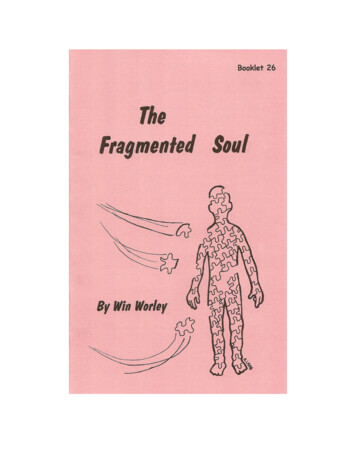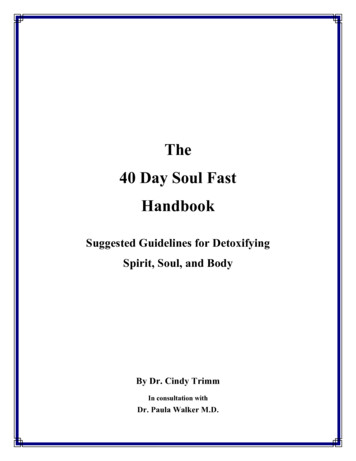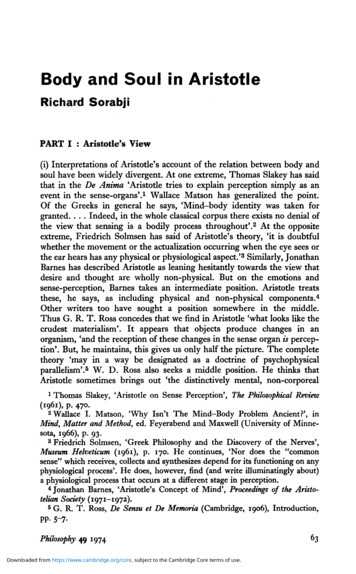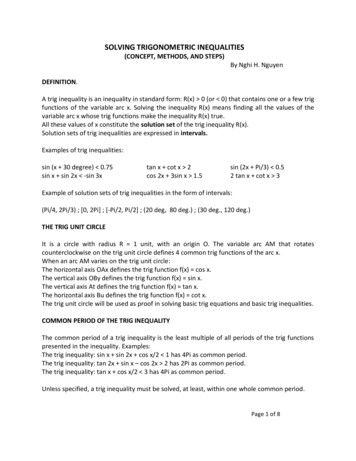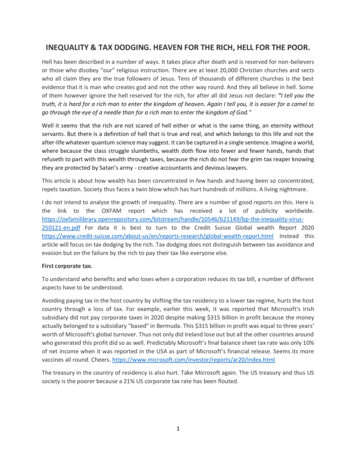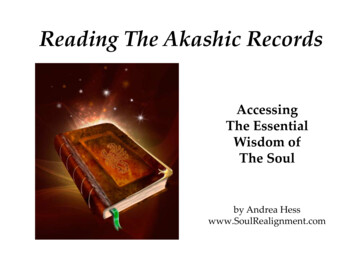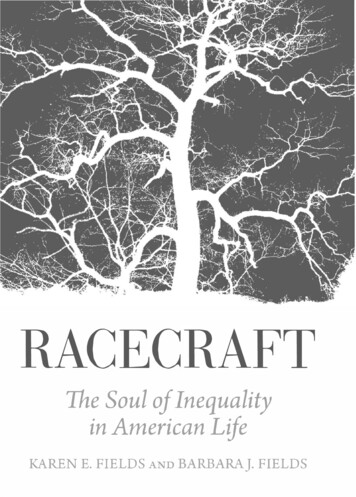
Transcription
RACE CRAFTThe Soul of Inequalityin American LifeKAREN E. FIELDSANDBARBARA].FIELDS
RACE CRAFT
RACE CRAFTThe Soul of Inequality in American LifeKAREN E. FIELDS ANDBARBARA J. FIELDSVERSOLondon NewYork
First published by Verso 2012 Barbara J. Fields and Karen E. Fields 2012All rights reservedThe moral rights of the authors have been asserted13 5 7 910 8 6 42VersoUK: 6 Meard Street, London W1 F OEGUS: 20 Jay Street, Suite 1010, Brooklyn, NY 11201www. versobooks.comVerso is the imprint of New Left BookseiSBN: 978-1-8 4467-995-9British Library Cataloguing in Publication DataA catalogue record for this book is available from the British LibraryLibrary of Congress Cataloging-in-Publication DataA catalog record for this book is available from the Library of CongressTypeset in Fournier by MJ Gavan, Truro, CornwallPrinted by in the US by Maple Vail
ContentsAuthors' NoteVllI ntroductionA Tour of Racecraft252 Individual Stories and America's Collective Past753 Of Rogues and Geldings954 Slavery, Race, and Ideology in the United Statesof AmericaIll5 Origins ofthe New South and the N egro Question1 496 What One Cannot Remember Mistakenly1717 Witchcraft and Racecraft: I nvisible Ontology inIts Sensible Manifestations1 938 Ind ividuality and the Intellectuals:An Imaginary Conversation Between Emile Durkheimand W. E. B. Du Bois225Conclusion: Racecraft and Inequality26 1Index29 1
Authors ' NoteSome readers may be puzzled to see the expression Afro-Americanused frequently in these pages, African-American being morecommon these days. We do not take a dogmatic view on such termi nological questions, preferring the approach of our grandmother,who used all but two of the terms that prevailed in her day (she diedin 1 987, just short of ninety-nine): Colored, Negro, Afro-American,and black. She used the term nigger and its close South Carolinacognate nigra only when quoting others with disapproval. Althoughwe leave our fellow citizens to their own choice, we prefer Afro American. We prefer it because it is time-honored, having deep rootsin the literary life of American English. M oreover, it leaves roomfor useful distinctions. Karen's husband Moussa Bagate, a natural ized American citizen born in Ivory Coast, is an African-American.Barack Obama, the child of a Kenyan father and a Euro-Americanmother, is an African-American. Karen and I, like Michelle Obama,are Afro-Americans. Karen's daughter Mai'm ouna, the child ofan African-American like the Obamas' daughters, and an Afro American, may choose whichever term she likes.The Introduction, Chapters 1 , 2, and the Conclusion are publishedhere for the first time. Chapters 3 through 8 are republished withminor changes. Details of original publication are given in notes atthe beginning of each chapter.
IntroductionIn the beginning was the deed.Ludwig Wittgenstein quoting Goethemisquoting john the ApostleThe Idols ofthe Trihe have theirfoundation in human nature itself, andin the trihe or race ofmen.Francis Bacon"Race " is the witchcraft ofour time.M. F. Ashley MontaguDuring the 2008 presidential election campaign, hardly a weekpassed without a reference to America's "post-racial" society, whichthe election ofBarack Obama supposedly would establish. If anyonereally was imagining such a thing as a post-racial A merica, whatthat might be was hard to pin down. Right through the campaign,references to "race" and the "race card " kept jostling the "post" in"post-racial. " When insinuations about Obama's supposed foreign ness cropped up, one journalist called that "the new race card." 1 Infact, it is among the oldest and most durable. Pronouncing native born Americans of African descent to be aliens goes as far back asThomas Jefferson and the other founders. M ore than a century later,D. W. Griffith's Birth of a Nation launched American cinema withPeter Beinart, "Is H e American Enough?" Time, October 20, 2008, ;6.
2Race craftthe same pronouncement in its opening sequence.2 And, a few daysafter the 2008 vote, suits filed in Pennsylvania and New Jersey tooverturn President Obama's election denied his A merican birth inorder to deny his citizenship. Far from holding mere playing cardsin their hands, those who brought suit had historical bedrock undertheir feet, and a ready-made place in national discourse.3 How andwhy a handful of racist notions have gained permanent sustenancein American life is the subject of this book.Other supposedly new notions are just as old and as deeplyembedded . Today's talk of "biracial" or "multiracial" peoplerehabilitates mulatto, quadroon, octoroon, and the like-yesterday'sterms for mixed ancestry. 4 Although they now reemerge in thecostume of post-racial progressiveness, not to say a move toward"an ideal future of racelessness,"; their origins are racist. Mulattomade its first appearance on the U S census in 1 850, after twotheorists, Josiah Nott, a physician, and J ames De Bow, a politi cal economist, decided to classify and count individuals with oneparent of African and one of European descent. 6 Today's lobby2 In the same vein, a 2002 sociological study counts the intermarriage ofCaribbean immigrants with white Americans, but not with black Americans, asevidence of assimilation. See Chapter 3, below.3 Howard Fineman, " Playing With Fire," Newsweek online, july 28,2009; Richmond Times-Dispatch, AP, "Suit Questioning Obama's EligibilityRejected," December 9, 2008. A Georgia native of the president 's age told aninterviewer that "if you had real change it would involve all the members ofObama's church being deported ." Quoted in jesse Washington, " Race C rimesAround the Country Spurred by Obama's Win," www.huffingtonpost.com,November 1 6, 2008.4 United States Bureau of the Census, The Census: A Social History(Washington, D C : USBC, 2002), II.; Quoted in Kim M . Williams, Mark One or More: Civil Rights in MultiracialAmerica (Ann A rbor, M I : U niversity of Michig-an Press, 2006), I.6 Nott 's medical p ractice included slaves. De Bow held the chair of politicaleconomy at the University of Louisiana at N ew O rleans. See Williams, MarkOne or More, 23; Reginald Horsman,]osiah Nott ofMohile: Southerner, Physician,and Racial Theorist (Baton Rouge, LA : Louisiana State U niversity Press, 1 987) .
Introduction3ing for a new census classification, called multiracial, defines itthe same way, "someone with two monoracial parents."7 Does itmatter that these citizen rejuvenators of obsolete racist categoriescannot reasonably share the agenda of their predecessors-to vali d ate the folk theory that mixed offspring are degenerate in mindand body?8 Today, some parents passionately seek a state-spon sored classification as a means of protecting their own childrenfrom feelings that enter all American children's minds via toxicdrip. "Self-esteem is directly tied to accurate racial identity," saidone mother.9 Whatever she thought she was saying about mixedancestry and mental health, the very phrase accurate racial identityought to set off sirens. Dangerous lies do not always dress the part.Where but in recycled racist fiction are "monoracial" parents tobe found to serve as guarantors of "accurate racial identity" ? Theleast one can say is that the fiction misrepresents the American expe rience. According to an estimate derived from decades of censusreports, some 24 percent of Americans listed in 1 970 as "white"probably had African ancestors, while more than 80 percent of thoselisted as "black" had non-African ones, which implies that therewere nearly twice as many white as black Americans of Africandescent. 10 Thomas Jefferson's descendants fit both descriptions. 1 17 Williams, Mark One or More, 44.8 This speculation, retailed as science, advanced the career of D r. N ott,who wrote De Bow that " my nigger hallucinations have given me morenotoriety than I had any idea of." De B ow once asked his friend to "do a lectu refor me on niggerology." Horsman, josiah Nott ofMobile, 1 0 1 , 1 09 . In Tjrpes ofMankind ( 1 854), N ott inferred degeneration from his definition of black andwhite Americans as separately evolved biological species (ibid., 102, 1 70, 270) .On American theories of " mongrelization," see Edwin Black, War Against theWeak: Eugenics and America 's Campaign to Create a Master Race (New York:Thunder's M outh P ress, 2003), 1 59-82.9 Susan Graham, national director of P roject RACE, quoted in Williams,Mark One or More, 43.10 Stephan Palmie, "Genomics, Divination, 'Racecraft ' , " AmericanEthnologist 34:2 (May 2007), 206.IIIn 1 873, Madison Hemings, the son of Sally Hemings and Thomas
4Race craftBut misrepresentation is not all. While redacting America's realhistory, the fiction revives an old fallacy: the move, by definition,from the concept "mixture" to the false inference that unmixedcomponents exist, which cannot be disproved by observation andexperience because it does not arise from them. 1 2 In the twentiethcentury, that logic had hideous real-world consequences. In thecomparative innocence of the nineteenth, the same logic aligneditself with a zeal for measurement, and percentages of mixtu rebetween (theoretically) unmixed individuals beckoned as avenuesof further investigation. In due course, the Census Bureau experi mented with the classifications quadroon and octoroon (respectively,an individual with a black grandparent or a black great-grand parent). Some states enacted laws to prevent people with Africanancestry from "passing" as white, and set up genealogical researchprocedures to detect violators.13 In sum, restoring notions of racemixture to center stage recommits us, willy-nilly, to the discreditedidea of racial purity, the basic premise of bio-racism.The latter, meanwhile, is neither gone nor forgotten. "Bio racism" is a more precise appellation for the nineteenth-centuryresearch just sketched than the more usual term, "race science. "For all the measuring and experimenting that research inspired, itfailed as science . 1 4 Modern genetics began afresh, and on a basis soJefferson, told an interviewer that his brother Beverly "went to Washington asa white man." John W. B lassingame, ed ., Slave Testimony (Baton Rouge, LA:University of Louisiana Press, 1 977), 474-80. See also Annette Gordon-Reed,Thomasjefferson and Sally Hemings (Charlottesville, VA : University of VirginiaPress, 1 997), and The Hemingses ofMonticello: An American Family (New York:Norton, 2008) .1 2 We take instruction from A. J. Ayer, Language, Trut/1, and Logic (NewYork: Dover, 1 946 [ 1 956], 78--9.1 3 B lack, War Against the Weak, 1 63--6. Findings by John H. Burma, "TheMeasurement of Negro Passing," Americanjournal ofSociology 52: 1 (July 1 946),1 8--22, raised a stir when they appeared in Collier 's magazine, and were followedby E. W. Eckhard 's " H ow Many Negroes ' Pass'?" in the same journal, 52:6(May 1 947), 498--500.14 Foundational work toward something new includes Julian Huxley and
Introductiondifferent as, perhaps, to deserve labeling non-racial. Race in today 'sbiology is not a traditionally named group of people but a statis tically defined population: "the difference in frequency of allelesbetween populations (contiguous and interbreeding groups) of thesame species. " 1; Unlike the units of bio-racism, these populationsare not held to be visible to the naked eye, or knowable in advanceof disciplined investigation. So the news is not good when scientistsstudying the human genome--adept in some of the twenty-firstcentury 's most sophisticated research techniques-hark back tothe old notion, yoking those techniques to a system of classifyingpeople that is steeped in folk thought. 16 They have a choice in thematter. Today's probabilistic methods and molecular-biologicalevidence by no means compel resort to the folk system. Indeed,they would seem to be incompatible with it. 17 Therefore, if the sci entific logic is indeed non-racial, the folk classification ought towither under its influence. To adhere to both old and new is to pickup and put down modern science with shameless promiscuity.However, such picking up and putting down has its defenders,sometimes offering defenses so remarkable as to justify this book'snew coinage, "racecraft." That term highlights the ability of pre- orA . C. Haddon, We Europeans ( 1 936), M. F. Ashley Montagu, Man 's MostDangerous Myth: The Fallacy of Race ( 1 942), William C . Boyd, Genea"cs andthe Races ofMan ( 1 950), and Frank B. Livingstone, "On the N on-existence ofHuman Races" ( 1 962) .1 5 Anthony Griffiths e t al., lntroduca"on co Genetics, Ninth Edition (NewYork: W. H . Freeman and Co., 2008), 206.16 See Troy Duster, " Bu ried Alive: The Concept of Race in Science, " inA lan H . Goodman, Deborah H eath, and M . Susan Lindee, eds., Genetic Nature/Culmre: Anthropology and Science Beyond the Two-Culture Divide (Berkeley, CA:U niversity of California Press, 2003), 258-77.17 Troy D uster writes that when scientists are asked to do their work withalready categorized samples, they "are necessarily 'buying in' to a taxonomicsystem that has little to do with a molecular geneticist 's professional training orexpertise . . . " In "Lessons from H istory: Why Race and Ethnicity Have P layed aMajor Role in B iomedical Research," Thejournal ofLaw, Medicine & Ethics 34:3(Fall 2006), 487-96, esp. 488.
6Race craftnon-scientific modes of thought to hijack the minds of the scientifi cally literate. Here, an anthropologist defends the traditional folkclassification: "After all, genetics has added very little to what sci entists, or indeed any observant people, have known for centuriesabout human groups . . . M odern genetics can be a bit more techni cally specific, but the basic truths are not new."18 The anthropologistproceeds to justify, on grounds of data-processing convenience,the routine use of "[subjects'] ' race' as categorical (check-box)variables in studies . . . to identify epidemiological risk factors. " 19Notice that, even where properly genetic risk factors exist, no partof the procedure, as described , prevents the subject's "race" frombeing taken, before the fact, to "explain" whatever is found afterthe fact. A psychologist has noted the "garbage in/ garbage out"circularity of "elegant experimental designs and statistical analy ses applied to biologically meaningless racial categories. "20 Thecheck-box method reduces "genetics" to a matter of querying, orsimply glancing at, the research subject. If "looks-like" geneticsand "says-so" genomics are respectable tools, what, indeed, couldmodern science add to popular belief?Fortunately, not all American scientists choose to yoke theirtechnological racehorse to the centuries-old oxcart. J. CraigVenter, whose imagination accelerated to warp speed the race tomap the human genome, reflected on his work autobiographicallyin A Life Decoded. 21 In his depiction, mapping the human genomerevealed nature's real world of irremediably diverse individuality-Venter's own (the first genome ever to be posted online) aswell as everyone else's.22 Nature's world of diverse individuality18 Ketmeth Weiss, "On Babies and Bathwater," American Etlmologist 34:2(May 2007), 242. Our italics.19 Ibid ., 243.20 Jefferson M. Fish, " Mixed Blood : An Analytical Look at Methods ofClassifying Race," Psychology Today, N ovember I, 1 995 .2 1 J. Craig Venter, A Lifo Decoded: My Genome, My Lifo (New York:Viking, 200 I).22 Thus, in contrast to the anti-individualism of "racial medicine" that
Introduction7is precisely not one that "observant people have known about"for centuries. Rather, that world stands open to fresh discoveriesabout nature in the make-up of human beings. Venter links his ownsusceptibility to asthma to probable genetic determinants that heshares with various statistical populations of Americans. P resentedin a series of insets, his own particulars disclose enormous com plexity. Not "known for centuries," for instance, is the family ofenzymes glutathione S-transferase (GST) , variants of which,found on chromosomes 1 and 1 1 , are believed to affect individuals'allergic response to diesel exhaust particles. Other sites also seemto be involved; Venter's own combination may be "read," and the"reading" suggests why he must reach for an inhaler on a foggySan Francisco day. 23Venter's way of introducing new science to a lay public seemsmore in accord with the ingrained individualism that so impressedearly visitors to America, like A lexis de Tocqueville in the 1 830s,than with the ingrained anti-individualism that the very word"gene" evokes for many today.24 Venter makes few concessionsto that anti-individualism, whatever phase of his work or life heis recounting; and race has no entry in his book's index. Whenquestions arose about his decision to take his private25 HumanG enome Project 's five samples from individuals who differed bywhat Americans call race, he replied that the point was to "helpcaptured head lines a few years ago (when the Food and Drug Administrationallowed two old d rugs to be re-patented together as supposed ly " race-specific"Bidil), some research geneticists are now pursuing the ultimate individualism intheir search for the cause of disease: sequencing the individual patient 's genome.N icholas Wade, "Disease Cause Is Pinpointed With Genome," New York Times,March I I , 20 1 0, A I .23 Venter, A Life Decoded, 79.24 Alexis de Tocqueville, Democracy in America, Vols. 1&2, trans. HenryReeve, with an Introduction by j oseph Epstein (New York: Bantam, 2000),383-440.25 Venter left the public Hu man Genome Project, at the National Institutesof Health, to create a private one at the Celera Corporation.
8Race craftillustrate that the concept of race has no genetic or scientific basis;and that there is no way to tell one ethnicity from another in the fiveCelera genomes"26-surely a caution against the widespread habitof treating " race" and "genetics" as though they were interchange able terms. Later, he told a B B C interviewer that " skin colour as asurrogate for race is a social concept, not a scientific one. "27Venter was surely mistaken, however, when he suggested that"greater scientific literacy" might help combat (altogether pre dictable) discrimination in the use of genomics.28 That bit of naivecatechism glares amid the sophistication of the book as a whole.Few can claim greater scientific literacy than James D. Watson, aNobel laureate for his work on DNA and founding director of thepublic Human G enome Project. Yet remarks he made to interview ers during his 2007 book-promotion trip to London owed less tothat scientific literacy than to the racist certainties in which manyChicagoans of his generation were reared. 29 Pronouncing himself"inherently gloomy about the prospects of Africa," Watson saidthat "all our social policies are based on the fact that their intelli gence is the same as ours-whereas testing says not really. " Indeed,in his view, reason is not properly regarded as " some universalheritage of humanity. " For evidence, however, the man of scienceresorted to personal impressions, haphazardly collected: " Peoplewho have to deal with black employees find this is not true. " Fromhis digest of anecdotes, he went on to prophesy that genetic evi dence for black people 's lesser intelligence would emerge withina decade.3026 Venter,LifoDecoded, 3 1 7.27 B B C News, "Lab Suspends Pioneer Watson," October 1 9, 2007, http: / Inews.bbc.co.uk .28 Venter,LifoDecoded, 3 1 7.29 B orn April 6, 1 928, he belonged to the same generation as Martin LutherKing, j r. (born january 1 5, 1 929) . Both were in their late thirties when, on August5, 1 966, Chicago residents attack ed King and other marchers with such violencethat the SC LC abandoned its campaign against segregation in the North.30 Helen Nugent, " Black People 'Less Intelligent ' Scientist Claims,"
Introduction9But a statement does not acquire validity because a dulyordained scientist utters it. The sirens went off immed iately.Certain of Watson's fellow molecular biologists took the floor witha scientifically correct formulation: It was " not possible to drawsuch conclusions from the work that has been done on DNA . " D r.Venter, who happened to be traveling in the United Kingdom atthe same time, said, " There is no basis in scientific fact or in thehuman genetic code for the notion that skin colour will be predic tive of intelligence. " 31 For his part, Watson did not defend himselfby citing his own scientific work to date or anyone else 's. Reporterslater observed that he at first denied what he had said, and seemedstunned. Perhaps a pre-scientific layer of his mind had taken overmomentarily. 32Not all who piled onto Dr. Watson can claim to differ funda mentally from him. Shortly after he published his own genomeonline, scientists at Iceland 's deCode G enetics startled the worldwith a revelation. Watson had " 1 6 times more genes of black originthan the average white European- 1 6 percent rather than the 1percent that most of his origin" would have. "This level is whatyou would expect in someone who had a great-grandparent whowas African."33 In other words, D r. Watson is someone whomwww.timesonline.co.uk, October 1 7, 20 1 0. As quoted in the Independenc(October 1 7, 2007), Watson's book affirmed that "there is no reason to anticipatethat the intellectual capacities of peoples geographically separated in theirevolution should prove to have evolved identically. Our wanting to reserve equalpowers of reason as some universal heritage of humanity will not be enough tomake it so." He is apparently a twenty-first-centu ry adherent of the Americantheory of " polygenism," promoted in the nineteenth centu ry by josiah Nott andHarvard 's Louis Agassiz.31 B B C News, "Lab Suspends Pioneer Watson."32 By contrast, while Venter's individual intelligence lights his book, heoffers no generalities about it; and, like race, intelligence does not appear in hisindex, thereby imposing the complexity of the whole book upon simplifying andselective readers.33 Robert Verkaik, " Revealed : Scientist Who Sparked Racism Row hasB lack Genes," Independent, December 1 0, 2007.
10Race craftnineteenth-century census takers would have classified as an octo roon if they had been able to see behind appearance. In those days,a technology able to expose "genes of black" origin (expressed inpercentages, no less) would have appealed to people who yearnedfor a sure-fire way to know an octoroon when you could not knowby looking. Watson's comeuppance, so deliciously prompt uponthe sin, occasioned so much laughter that it is easy to miss theunhappy fact that deCode Genetics' researchers themselves yokedthe new technology to the uses of yore. 34As if all that were not enough, now comes a techno-fad that pur ports to determine the so-called tribal origins of Afro-Americanswith the help of Personal G enetic Histories (P G H s).35 The samemethod and logic might equally have revealed Dr. Watson's Africantribal origins to the world.36 Anyone who is committed to think ing of tribes as objectively occurring biological phenomena cannotthink differently about bio-racists' races.37 What an irony, then,if the World War II defeat of the Nazis did indeed discredit racescience, only to have the yearning for " identity" and the jaw swabsof Afro-American bio-genealogists abet its revival. Whateverthe "post" may mean in " post-racial," it cannot mean that racismbelongs to the past. Post-racial turns out to be-simply-racial;which is to say, racist.34 William Faulkner's Light in August (Norwalk, CT: Easton Press, 1 992[ 1 932], 344, 346, 3j0) circles the troubled terrain of those uses of yore . Theambiguity of joe Christmas, the "white nigger that did that killing up at jeffersonlast week," maddens the townspeople. " He dont look no more like a nigger thanI do," one declares. And another: "He never acted like either a nigger or a whiteman . . . That was what made the folks so mad . . . It was like he never even knewhe was a murderer, let alone a nigger, too."3; Stephan Palmie provides an astute analysis in " Genomics, Divination,'Racecraft,"' 207.36 The late jack Temple Kirby wrote a dead-serious yet uproarious accountof his own tribal genealogical investigations, based on historical documents,in "AN CESTRYdotB O M B : Genealogy, Genomics, M ischief, Mystery, andSouthern Family Stories," journal ofSouthern History 76 (February 20 1 0), 3-38.37 Palmie, " Genomics, Divination, 'Racecraft,"' 206.
IntroductionIISomething is afoot that is the business of every citizen whothought that the racist concepts of a century ago were gone and good riddance!-as a result of the Civil Rights Movement.The continued vitality of those concepts stands as a reminderthat, however important a historical watershed the election of anAfrican-American president may be, America's post-racial erahas not been born. Perhaps it can be made if America lets thoseconcepts go. But if they are hard to let go, why is that? What arethey made of? How do they work? And what work do they do?Those are our subjects in the coming chapters. For now, we sketchour answers briefly and bluntly, so as not to preempt the essays tocome. One general point must be made at the outset, however, andwith an important caveat: Racist concepts do considerable work inpolitical and economic life; but, if they were merely an appendageof politics and economics, without intimate roots in other phases oflife, their persuasiveness would accordingly diminish.From very early on, Americans wove racist concepts into a publiclanguage about inequality that made "black" the virtual equiva lent of "poor" and "lower class," thus creating a distinctive idiomthat has no parallel in other Western democracies. The FrenchRevolution assigned universal validity to the slogan Liberti!Egaliti! Fraterniti! By contrast, America's rendering of the samesentiments added asterisks, for it had to make sense of an anomalousreality: the presence of native-born people who were "foreign,"hardworking people who were not free. When Tocqueville soughtto convey to French readers the racist prejudice he found in theUnited States, North and South-a signal exception to the enthu siasm for equality that he duly noted-he wrote that he could drawno direct comparison from French experience. Instead he proposedas an "analogy" the gut-level physical repugnance aristocrats felttoward their equally white, but unequally born, compatriots.38 Inthat tiny vignette of white-on-white struggles in France lay the38Tocqueville, Democracy in America, 414.
12Race craftkernel of a legitimate public language to come, in which the Frenchmight tackle class inequality in straightforward terms.In America, straightforward talk about class inequality is allbut impossible, indeed taboo. Political appeals to the economicself-interest of ordinary voters, as distinct from their wealthycompatriots, court instant branding and disfigurement in the pressas divisive " economic populism" or even " class warfare. "39 Onthe other hand , divisive political appeals composed in a differentregister, sometimes called " cultural populism," enlist voters' self concept in place of their self-interest; appealing, in other words,to who they are and are not, rather than to what they require andwhy. Thus, the policies of the 1 980s radically redistributed incomeupward. Then, with "economic populism" shooed from the publicarena, "cultural populism" fielded something akin to a marchingband. It had a simple melody about the need to enrich the "invest ing" classes (said to " create jobs"), and an encoded percussion:"culture wars"; " welfare mothers" ; "underclass" ; " race-and-IQ" ;"black-on-black crime"; " criminal gene"; on and on.40 Halfwaythrough the decade, as the band played on, a huge economic revo lution from above had got well under way. The poorest 40 percentof American families were sharing 1 5.5 percent of householdincome, while the share of the richest 20 percent of families hadrisen to a record 43.7 percent, and the trend appeared to be (and hasturned out to be) more and more of the same.4139 H owell Raines, "Winning the Populism P R War," Washington Post,online edition, July 27, 2004. On the salience of this theme in 20 1 1 , see PaulKrugman, "Panic of the Plutocrats," New York Times, October I 0, 20 1 1 , A23.40 I ts predecessor in the 1 890s, the so-called Gilded Age, marched with twovarieties of racism, one directed against Afro-Americans, and the other againstimmigrants from eastern and southern Europe. Aiming to eliminate " the unfit,"bio-racism supported both varieties, and, besides, a eugenics program againstthe white poor. See Black, War Against the Weak, 4 1 3- 1 9.4 1 Derrick Bell, "After We 're Gone: P rudent Speculations on America in aPost-Racial Epoch," St. Louis University Law journa/34 ( 1 990), reprint, 6. TheUS census first tracked such figu res in 1 947. Today's figures, according to David
Introduction13The late Derrick Bell seems to have coined the phrase "post racial. " In his 1 990 essay, "After We 're Gone: P rudent Speculationson America in a Post-Racial Epoch," he intended not to gesture ata vague future state, but to examine the relationship between twodevelopments of the 1 980s: the need to manage politically the radicalredistribution of income toward the well-to-do and the suffocationof public sentiment favorable to civil rights.42 Bell used allegory.Space Traders arrive with a proposal for America's deciders. Theywill sell America a proven technology for producing unlimitedwealth and will buy in return every living Afro-American. Theirdeal poses constitutional and moral problems, obviously, but alsoa practical one. The practical problem is not whether to accept thedeal (which is inevitable) but how to couch, stage-manage, and spinit. B ell portrays the ensuing National Conversation with hilariousfidelity to its real-world models. In taking the deal, ho
in the literary life of American English. Moreover, it leaves room for useful distinctions. Karen's husband Moussa Bagate, a natural ized American citizen born in Ivory Coast, is an African-American. Barack Obama, the child of a Kenyan father and a Euro-American mother, is an African-American
